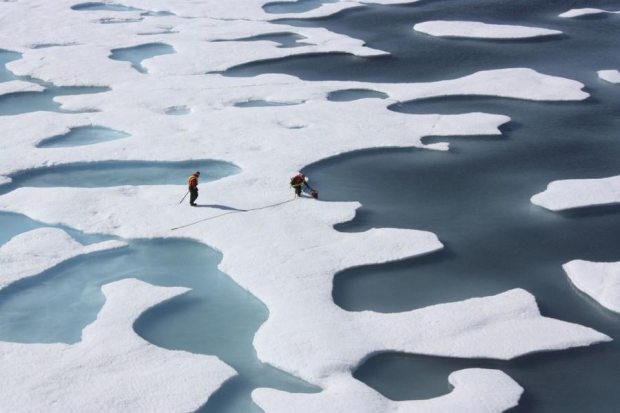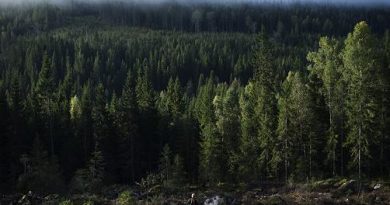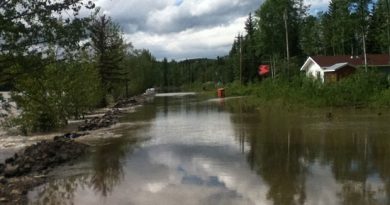Scientists: Rapid Arctic changes require fast action

(Kathryn Hansen / NASA photo )
As world leaders met in Sweden to discuss the state of the region at the Arctic Council on Wednesday, a group of scientists from across the globe released a book-length report examining how the Arctic’s changing landscapes — economic, societal and geological — may impact the North.
Uncertainty is certain, they say, and now is the time to create strategies to deal with whatever lies ahead.
“Today we are in one place, and tomorrow we are in an entirely different Arctic,” said Gary Kofinas, lead author on one of the study’s sections and a professor of resource policy and management at the University of Alaska Fairbanks. It’s time to “go ahead and navigate those changes.”
A call to action
The Arctic Resilience Interim Report 2013 is the first of two reports planned by the Stockholm Environmental Institute and Stockholm Resilience Center to address the Arctic’s rapidly changing landscape. The report is a call to action for governments to start addressing changes in the Arctic, where action has lagged behind ecological and societal shifts so far.
For example, rural Alaska villages that are being washed into the sea as shorelines erode face a major dilemma: Little to no federal support is available for the enormously expensive endeavor of moving a whole community. Yet at the same time, government agencies won’t invest in villages with limited lifespans.
At least four Alaska villages require complete relocation: Newtok, Shishmaref, Shaktoolik and Kivalina. Studies show that moving a village will cost tens of millions of dollars, and there’s no consensus yet on who is responsible for those costs. (The Guardian is running a series this week about the challenges of relocating Newtok and its 350 residents.)
Scientists want to change that. The Arctic Resilience Report urges governments to plan for such issues instead of reacting after the fact. Nations must set up strategies for dealing with near-certain changes, scientists say, so that far north residents are ready to adapt.
But will nations hear their cry and respond? “It depends on which ones you are talking about,” Kofinas said.
Rapid Arctic change
Last week, President Obama’s administration released the “American National Strategy on the Arctic,” an unexpected and potentially good development for Arctic inhabitants, Kofinas said. The strategy will position the U.S. to respond to environmental and security concerns stemming from increased activity in the region, the Council on Foreign Relations reports.
Still, the Arctic is changing “a lot faster than the policies,” said Martin Robards, co-author of several studies in the Arctic Resilience report and director of the Arctic Beringia Program with the Wildlife Conversation Society in Fairbanks.
The Arctic Resilience “gets the discussion going across different countries,” Robards said, but whether nations will act on those discussions in a timely manner remains to be seen.
The report takes a broad focus. Instead of narrowing their analysis to a singular aspect of Arctic change, such as geology or politics, researchers took a 30,000-foot view, using “resilience” as the lens through which they examined shifting regional changes.
Social and ecological systems are not separate, they say. As the Arctic changes, resilience is the “capacity and ability of society to respond to the changes that may occur,” Kofinas said. “Resilience isn’t just about keeping things as they are,” he continued, but instead is a way to “rethink how we do business.”
‘Remarkably diverse and resilient’
One example of resilience noted in the report were the changes faced by indigenous populations in Canada’s Yukon Territory from the 1940s through today. The reintroduction of wood bison in the 1930s slowly shifted the people’s food supply away from moose to bison, while the construction of the Alaska Highway, completed in 1942, brought a large U.S. military presence, new settlements and the introduction of a wage economy. Meanwhile, climate patterns were in a warming cycle, and political problems, from World War II to federal territorial shifts, affected the social landscape.
Yet through the passing years and changing landscapes, “people in the territory have adapted effectively to these changes and the (region) remains remarkably diverse and resilient,” the report states.
So how did the people cope?
• By learning to live with change, such as shifting their food sources;
• By nurturing diversity and renewal, through language training and oral histories;
• By organizing efforts to manage ecosystems; and
• By using new knowledge, such as community-based research initiatives (the complete case study with all factors and strategies is available in the report).
All of these changes, and strategies to adapt to them, happened in tandem. And that’s how the changes facing today’s Arctic are occurring as well, researchers say.
The Arctic now faces both gradual and abrupt changes that will have global effects on societies and ecosystems, the report says. For instance, as sea ice melts — at paces faster than anticipated — global temperatures may be affected. Ice loss heats the ocean, affecting jet streams that send systems of cool and warm air across the globe, The Guardian reports.
While many changes will be negative, opportunities may also present themselves as the Arctic shifts. As the sea ice melts and opens new landscapes, opportunities for new Arctic shipping routes open as well. Evidence of increased salmon populations on the North Slope and changes in the distribution of moose populations also point to potential new food sources and economic opportunities, Kofinas said.
Up next for scientists working on the report are two more years of collaboration before releasing their final Arctic Resilience Report in 2015.
Contact Laurel Andrews at laurel(at)alaskadispatch.com



